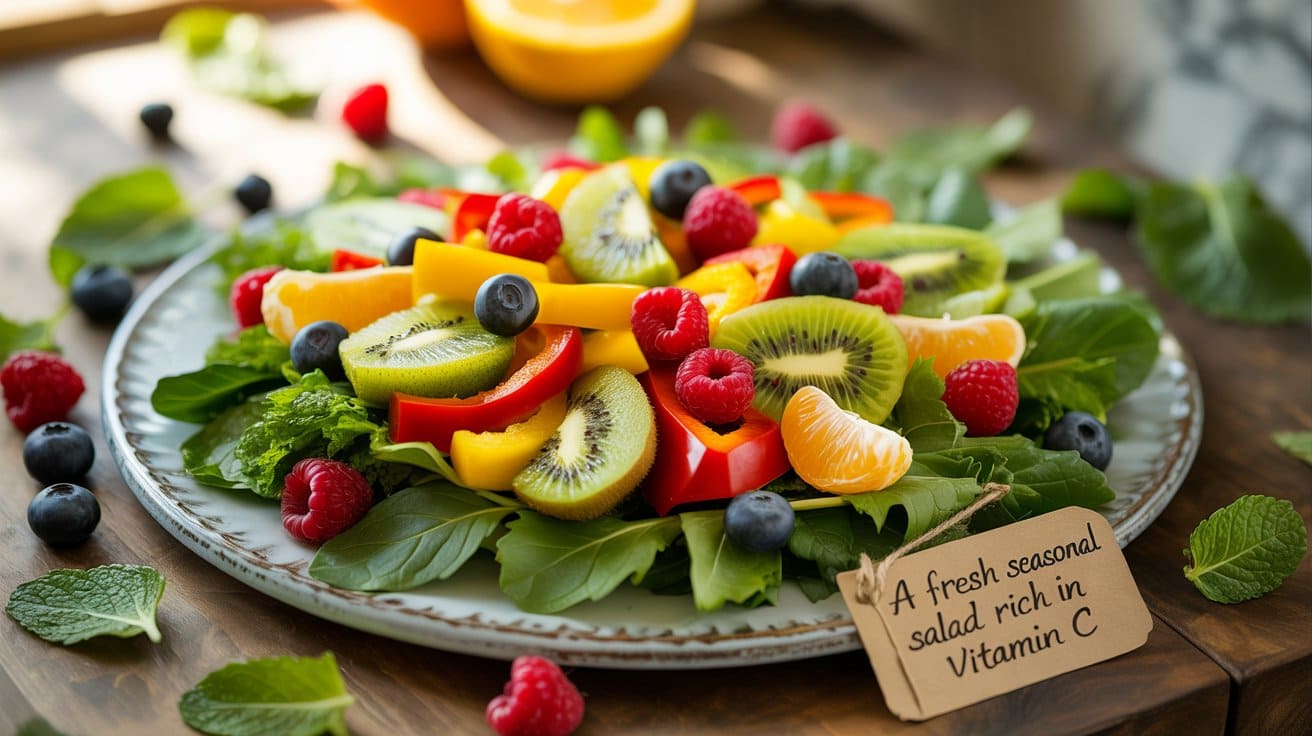
Introduction
As late summer fades into early autumn, many regions experience cooler nights, shifting humidity, and the start of school and work routines—conditions that often correlate with a rise in upper respiratory tract infections (URTIs). While no single food can “bullet-proof” immunity, aligning your plate with the seasons can supply the vitamins, minerals, bioactive phytochemicals, and fermented probiotics your immune system relies on. In this transitional window, nature conveniently offers produce rich in vitamin C, vitamin D (from UV-exposed mushrooms), zinc, polyphenols (like EGCG from green tea), beta-glucans from mushrooms and oats, and fermented dairy cultures—all nutrients or compounds studied for immune relevance. High-quality research, including randomized trials and meta-analyses from Asia, North America, and Europe, supports practical choices such as green tea, mushrooms, yogurt/kefir, garlic, berries, citrus, bell peppers, and oily fish. Wikipedia+1PubMed+1PMC+1
SEO keywords: seasonal immune-boosting foods, late summer foods, early autumn diet, vitamin C fruits, probiotic yogurt, mushrooms beta-glucans, green tea catechins, zinc and colds, vitamin D and immunity, Mediterranean diet
Key Points (Quick Take)
- Favor seasonal produce high in vitamin C (kiwi, peppers, citrus, berries) and polyphenols (grapes, pomegranates). Wikipedia
- Include fermented dairy (yogurt, kefir) or fermented vegetables for probiotic support against URTIs. PMCScienceDirect
- Rotate mushrooms (shiitake, maitake) and oats/barley for beta-glucans, which can modulate innate immunity. UV-exposed mushrooms also provide vitamin D. PMC+1
- Sip green tea for catechins (EGCG)—supported by Japanese randomized trials for influenza/URTI prevention. PMCPLOSSpringerLink
- Zinc can shorten colds in some trials, but evidence is mixed in recent reviews—avoid mega-dosing. PubMedCochrane LibraryFrontiers
- A Mediterranean-style pattern—fruits, vegetables, whole grains, legumes, nuts, olive oil, fish—remains a sound, evidence-backed base for overall health. Wikipedia
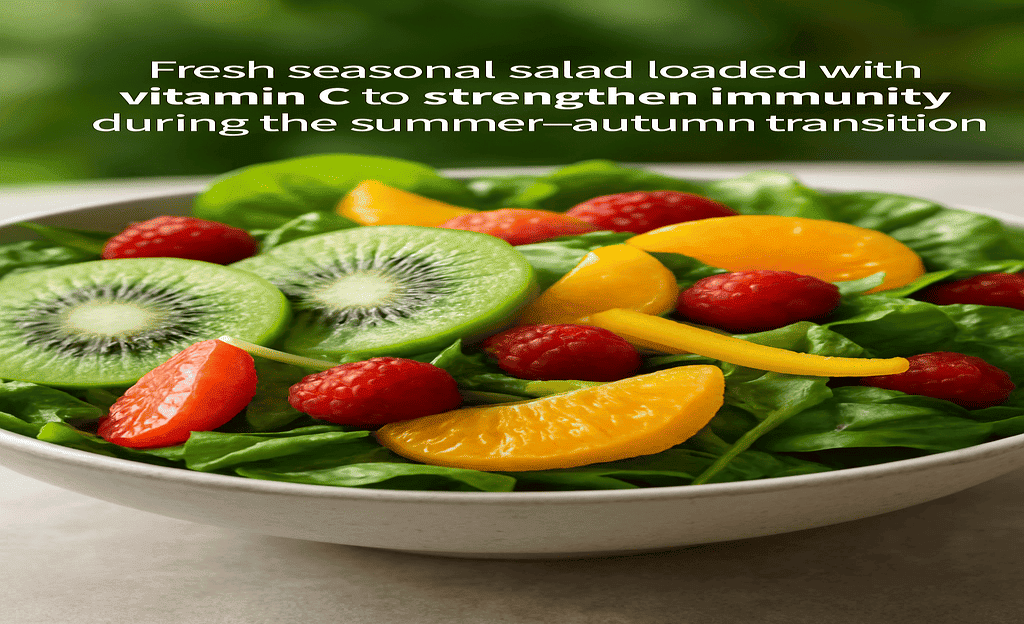
Body
1) Vitamin C-rich late-summer and early-autumn produce
Vitamin C supports normal immune function and acts as a water-soluble antioxidant. Seasonal standouts include kiwifruit, bell peppers, citrus, berries, broccoli, and kale—all widely available from late summer into autumn in many regions. Authoritative food composition tables highlight these foods as top sources of vitamin C per 100 g. Building a daily habit of 2–3 vitamin C-rich servings can be a simple, food-first immune strategy. Wikipedia
Practical plate idea: Toss a late-summer salad with mixed greens, sliced kiwi, red/yellow bell pepper, cherry tomatoes, and a lemon-olive oil dressing. Pair with grilled fish or chickpeas for protein.
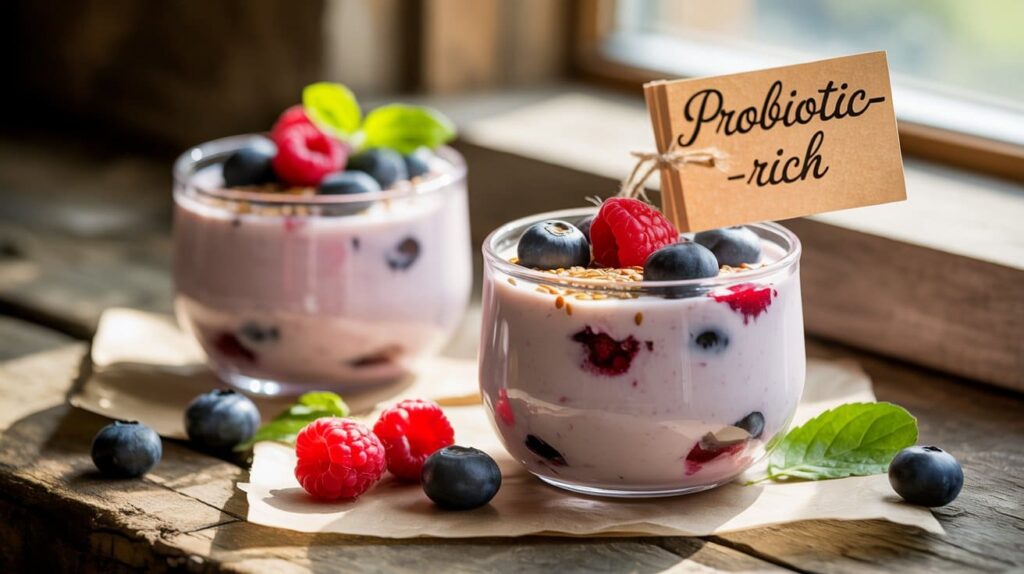
2) Probiotics from fermented dairy and their URTI evidence
A growing evidence base links probiotic-rich yogurt and fermented dairy to fewer or shorter respiratory infections. Meta-analyses and multicenter randomized controlled trials report reduced incidence of URTIs with specific probiotic strains in yogurt or fermented milk, though effects vary by strain, dose, and population. This makes daily plain yogurt or kefir a low-cost, widely accessible option during the summer-to-autumn transition. PMCScienceDirect
Tip: Look for labels listing live cultures (e.g., Lactobacillus/Lacticaseibacillus and Bifidobacterium) and keep added sugars minimal.
3) Mushrooms and cereal fibers: beta-glucans for the innate immune response
Beta-glucans—found in mushrooms (shiitake, maitake, oyster), yeast, oats, and barley—have been shown to modulate immune cell activity (e.g., macrophages, NK cells). Reviews and clinical studies indicate shiitake preparations can increase certain immune cell subsets, and broader literature suggests beta-glucans help “train” innate immunity. Moreover, UV-exposed mushrooms are one of the few natural dietary sources of vitamin D, a nutrient with extensive data linking supplementation to small reductions in ARI risk. PMC+1WikipediaPubMed+1
How to use: Sauté mixed mushrooms with garlic and olive oil; add to whole-grain toast (oats/barley in the bread) or fold into an omelet.
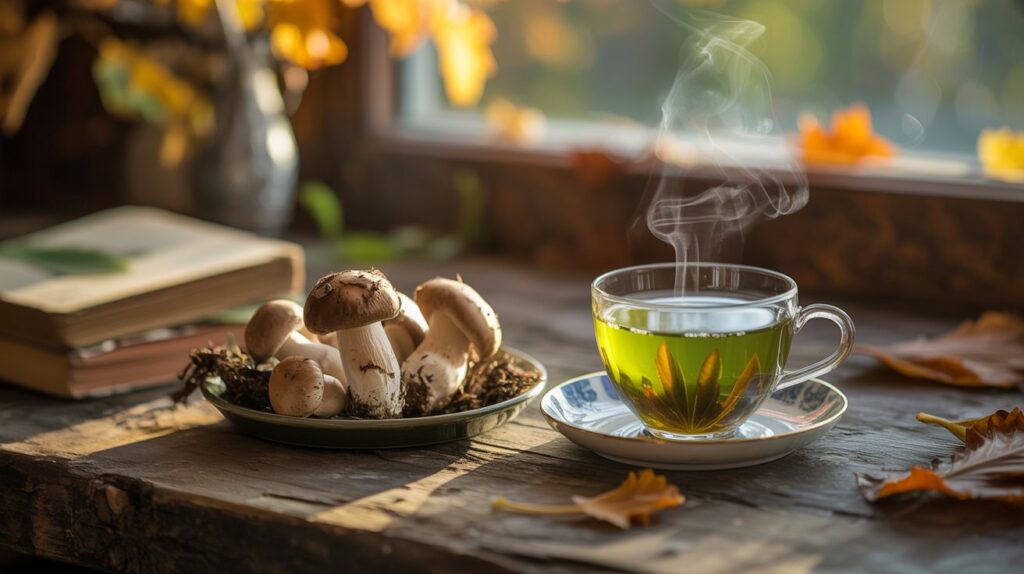
4) Green tea catechins (EGCG) from Asia: human trials on influenza/URTIs
Japan has led several clinical studies on green tea catechins (sometimes with theanine) showing reduced incidence of influenza or URTIs in adults, including healthcare workers, and in some gargling or capsule trials. While not a cure, this is one of the few food-derived polyphenol areas with randomized human data supporting infection prevention. Enjoy 2–3 cups daily, preferably unsweetened. PMCPLOSMDPI
Note: Green tea also brings hydration and warm fluids as temperatures drop in early autumn.
5) Zinc: nuanced evidence and practical caution
Zinc is essential for immune function. Meta-analyses of zinc lozenges suggest a meaningful reduction in cold duration when started within 24 hours of symptoms, with doses often around 75–100 mg/day elemental zinc in trials. However, a 2024 Cochrane update concluded evidence is insufficient to recommend zinc broadly for prevention or treatment, highlighting heterogeneity and potential side effects (nausea, taste changes). In food-first strategies, focus on zinc-rich foods like shellfish, beef/lamb, pumpkin seeds, sesame, legumes, and whole grains; if considering supplements, use moderate doses and short courses. PubMedCochrane LibraryFrontiers
6) Garlic: promising but limited clinical evidence
Garlic contains organosulfur compounds (e.g., allicin) with antimicrobial properties. A UK double-blind randomized study suggested an allicin-containing garlic supplement reduced cold incidence and symptom burden versus placebo, though the evidence base remains small and product-specific. Culinary garlic, however, is an easy, flavorful addition to many immune-friendly dishes. SpringerLink
7) Vitamin D: keep an eye on baseline status
It’s common for vitamin D levels to drift downward as daylight shortens. Individual participant data meta-analyses and updates show small but significant reductions in ARI risk with vitamin D supplementation, particularly with daily doses (400–1000 IU) and in those with lower baseline levels. Food sources include oily fish (sardines, salmon), egg yolks, and UV-exposed mushrooms, but testing and supplementation may be warranted depending on your context and clinician guidance. PubMed+1The Lancet
8) A Mediterranean-leaning seasonal pattern
For an easy framework, map late-summer/early-autumn choices onto a Mediterranean-style eating pattern: vegetables, fruits, legumes, nuts, seeds, whole grains, extra-virgin olive oil, and moderate fish/dairy. This pattern has broad evidence for cardiometabolic benefits and aligns naturally with seasonal produce in many regions, including North Africa and Southern Europe. Wikipedia
Table: Late Summer → Early Autumn Immune-Smart Foods
| Season Window | Food (Example) | Notable Nutrients/Compounds | Immune-Relevant Notes |
|---|---|---|---|
| Late Summer | Kiwifruit, Bell peppers, Berries, Citrus | Vitamin C, flavonoids | Supports normal immune function; antioxidant defense. Wikipedia |
| Late Summer | Yogurt/Kefir (plain) | Probiotics (live cultures) | RCTs/meta-analyses report fewer URTIs with specific strains. PMCScienceDirect |
| Late Summer → Early Autumn | Green tea | Catechins (EGCG), theanine | Japanese RCTs show reduced influenza/URTIs with catechins. PMCPLOS |
| Early Autumn | Mushrooms (shiitake, maitake) | Beta-glucans, vitamin D (if UV-exposed) | Beta-glucans modulate innate immunity; vitamin D supports ARI risk reduction. PMC+1PubMed |
| Both | Oats/Barley | Beta-glucans, fiber | Innate immune “training” and gut support. PMC |
| Both | Garlic | Organosulfur compounds (allicin) | Small UK RCT suggested fewer colds; culinary use encouraged. SpringerLink |
| Both | Shellfish, legumes, seeds | Zinc | May shorten colds if begun early; evidence mixed—avoid mega-doses. PubMedCochrane LibraryFrontiers |
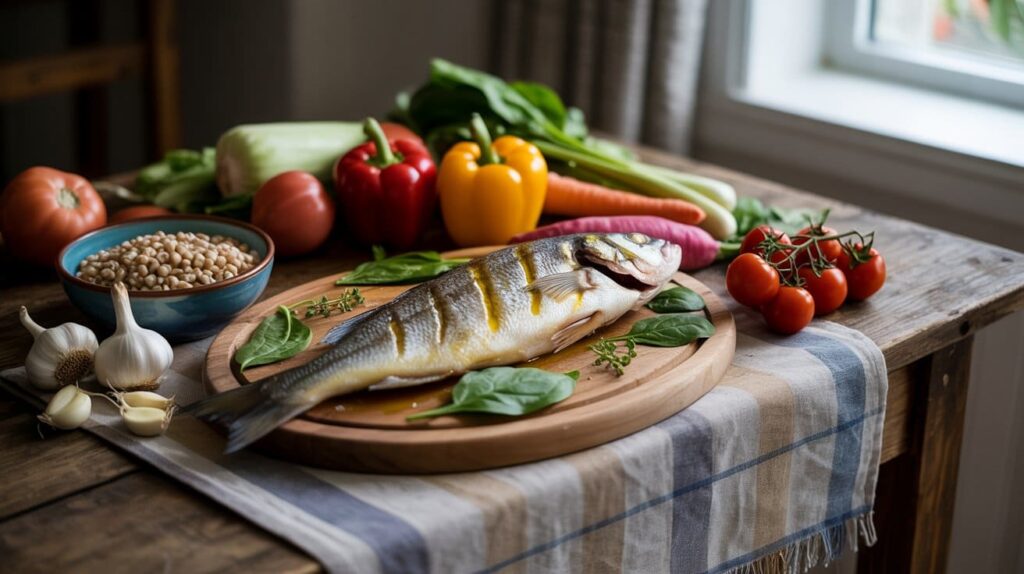
Simple “Figure”: Your 7-Day Transition Template
- Daily: 2–3 vitamin C-rich servings (e.g., kiwi + peppers), green tea (2–3 cups), olive oil-based meals. WikipediaPMC
- Most days: 1 serving fermented dairy (yogurt/kefir) or fermented vegetables for probiotics. PMC
- 3×/week: Mushrooms + a whole-grain (oats/barley) for beta-glucans. Consider UV-exposed mushrooms. PMCWikipedia
- 2×/week: Oily fish for vitamin D and omega-3s (or discuss vitamin D testing with your clinician). PubMed
- As needed: Culinary garlic; zinc-rich foods; be conservative with zinc supplements. SpringerLinkCochrane Library
Conclusion
Shifting from late summer to early autumn is the perfect moment to re-align your diet with seasonal abundance. Emphasize vitamin C-rich produce, probiotic-containing fermented dairy, beta-glucan sources (mushrooms, oats, barley), and polyphenol-rich green tea—a quartet with real-world, human data supporting immunity during common-cold season. Add zinc-rich foods and garlic for balanced coverage, and anchor everything in a Mediterranean-style pattern emphasizing whole, minimally processed foods. While supplements can play a targeted role (notably vitamin D when levels are low), food-first strategies remain sustainable, safe, and culturally adaptable. With these evidence-guided choices, you’ll move through the season change with a stronger nutritional foundation for everyday immune health. PMC+2PMC+2Wikipedia
References (selected)
- Vitamin C sources and amounts (Wikipedia): “Vitamin C” (updated recently): rich plant sources table and background. Wikipedia
- Vitamin D & acute respiratory infections (Europe/UK/US collaborators): Martineau AR, et al. BMJ 2017; individual participant data meta-analysis. Update and commentary by Jolliffe et al. 2021 and 2024. PubMed+1The Lancet
- Probiotics & URTIs (Iran/Europe/International teams): Rashidi K, et al. Nutrients 2021 meta-analysis; Odintsova V, et al. 2021 multicenter RCT (fortified yogurt). PMCScienceDirect
- Mushrooms & beta-glucans (Europe): Cerletti C, et al. 2021 review; mechanistic overview on dietary glucans. PMC+1
- Beta-glucans overview (Wikipedia): “Beta-glucan” page for background/definitions and common sources. Wikipedia
- Green tea catechins (Japan): Matsumoto K, et al. 2011 RCT on healthcare workers; Ide K, et al. 2014 (gargling/URTI); narrative/systematic updates. PMCPLOSSpringerLink
- Zinc and the common cold (Finland/International): Hemilä H, et al. 2017 meta-analysis; Cochrane 2013 review; 2024 Cochrane update discussion noting insufficient evidence. PubMedCochrane LibraryFrontiers
- Mediterranean diet (Wikipedia): Evidence-summarizing entry on dietary pattern and health outcomes. Wikipedia
- Garlic RCT (UK): Josling P. Advances in Therapy 2001; allicin-containing garlic supplement vs. placebo. SpringerLink






